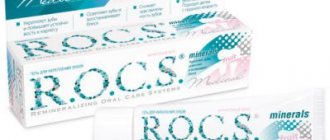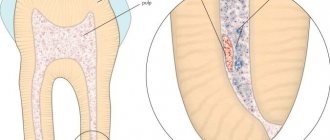Until the middle of the last century, the choice of filling material was small. For restoration, amalgams (compounds of metals with mercury) and phosphate and silicate cements were used. Later, acrylic materials appeared, followed by composite materials.
Later, glass ionomer cements were developed, which are still used for permanent filling today. They have not only universal properties:
- non-toxic;
- biocompatibility;
- high strength,
but also different consistencies (powders, fluid composites).
Similar compositions are used for temporary fillings. The only difference is that the seal is not permanently fixed and can be easily removed. In each specific case, the doctor eliminates the danger of microbial exposure from the outside. To reduce the risk of secondary caries, therapeutic pads are used.
Why do you need to fill teeth?
The main task that fillings solve is to prevent the development of carious tooth decay. After high-quality cleaning of the damaged cavity and filling it with a filling, the risk of secondary caries will decrease to almost zero. This allows a person to lead a normal lifestyle and not experience any discomfort. In addition, fillings allow you to restore the aesthetics of your teeth.
Fillings are also used in case of tooth damage due to mechanical stress. This could be a chip from an impact or abrasion of a large layer of enamel.
Types of fillings by service life
Depending on the period during which the fillings are in the tooth cavity, they are divided into two types - temporary and permanent. They differ from each other in the material from which they are made, and also have different appearance.
Temporary
Temporary tooth fillings are used when treatment is carried out in two stages. At the first of them, the doctor cleans the cavity from caries. Next, it is necessary to place special medications into the tooth that disinfect the tissues or promote the death of the dental nerve. This approach is needed in case of deep caries damage or the presence of its complications, for example, periodontitis.
Temporary fillings are also needed if additional time is needed to make a permanent one. Certain types of fillings are made in a laboratory using impressions that are taken from a cleaned cavity. At the same time, at the first appointment with the doctor, a temporary material is installed, and at the next one he can install a permanent one.
Permanent
Permanent fillings are installed during one-stage treatment of caries. In this case, at the first appointment, the doctor cleans the affected cavity and places a permanent filling in it. This method is suitable if we are talking about superficial or medium caries.
Basic materials for filling
If we classify filling materials according to their intended purpose, they can be divided into 4 main groups:
- permanent - restore the shape of the tooth;
- temporary - to close a carious cavity for the duration of treatment);
- cushioning (therapeutic, insulating);
- used for filling canals;
Types of fillings according to materials used
The materials used to make fillings can vary from precious metals to modern polymers. They may differ in their appearance, wear resistance and price.
Cement based
Cement tooth fillings have been around for a very long time. Their use was most common before the advent of various modern materials. This is due to the low cost of the components that make up them.
Other advantages of such fillings include:
- low shrinkage;
- tight fit to the tooth, which prevents the possibility of falling out or the appearance of secondary caries;
- long service life.
As for the disadvantages of these fillings, the main one is the unnatural color of the material, which often differs from the surface of the tooth, as well as the likelihood of its pigmentation under the influence of coffee, food coloring, etc.
Plastic
Plastic fillings are used quite rarely. Most often they are used to close small cavities, and are also used in pediatric dentistry for filling baby teeth. Plastic fillings are often used as temporary fillings in multi-stage treatment. Like the previous option, they are low cost.
Among the disadvantages of such fillings are strong shrinkage of the material and the presence of a porous structure, which can cause secondary caries, since it does not properly protect against bacteria.
Amalgam
Amalgam are tooth fillings made of metal alloys with different compositions. It may contain mercury, tin, gold, etc. One or another option should be chosen depending on personal preferences and the available budget, since some of them are very expensive. A significant disadvantage of such a filling is its unnatural color, which differs significantly from the shade of tooth enamel.
The main advantage of this type of filling is its durability. Amalgam fillings have one of the longest lifespans and are often chosen for placement in posterior teeth.
Ceramics
Ceramic fillings are among the most expensive. Their advantages:
- they have natural shades and are therefore invisible on the teeth;
- do not change color under external influences;
- have a long service life.
The downside is that such fillings must be made separately, so the treatment process always takes place in several stages.
Light-curing composites
One of the most modern and high-quality types of fillings are light-curing composites. They are highly durable and aesthetically pleasing, since the doctor can always choose the most suitable shade that will not differ from the patient’s natural tooth enamel. The main advantage of this material for fillings is that it hardens only under the influence of a special lamp, so the doctor can regulate this process and adjust the shape of the tooth filling before its final hardening.
Glass ionomer cement material
Glass ionomer cement is a material that combines the properties of silicate and polyacrylic systems. Such fillings are used extremely rarely, although they have high adhesion to tooth tissue and other materials. This ensures the durability of the filling and its good fit. However, this material has mild toxic properties, so it is gradually being abandoned in dentistry.
Metal fillings
Filling teeth with amalgam
Amalgam is a medical metal containing tin, zinc, mercury and silver. Most often, this filling is placed on the distant chewing teeth. Modern dentists use copper and silver amalgams, where these metals predominate.
The advantages of amalgam-based fillings are as follows:
- Long service life, which can reach 15 years or more;
- Strength;
- Low price;
- Plastic;
- The possibility of preserving tooth color appears if fillings from the latest generations of amalgam are used;
- Easy to install;
- Tight edge seal.
Disadvantages of using amalgam for filling teeth:
- Low aesthetics: the filling will stand out noticeably against the background of the tooth;
- Long curing time;
- The release of mercury vapor, which most likely affects not the patient himself (it has been proven that even when wearing 10 amalgam fillings, the body will not receive mercury exceeding the maximum permissible concentrations), but rather the employees of the dental office;
- It is impossible to install a gold crown, since the amalgam filling will be destroyed;
- Shrinkage of the filling;
- Increased thermal conductivity.
Gold alloy for filling teeth
Fillings made from metals, including their precious analogues, are not popular in modern dentistry, as they are too noticeable on the teeth. While most patients strive for maximum naturalness and naturalness. However, those who decide to install such a filling should know about its advantages and disadvantages.
Advantages of gold alloy fillings:
- Long service life;
- Increased strength.
Disadvantages of gold alloy fillings:
- High price for a filling;
- Impossibility of installation with amalgam fillings.
Chemically cured composites
The main property of chemically cured composites for fillings is their polymerization exclusively when exposed to certain substances. That is, such materials harden evenly after mixing their original components. This makes the filling process more controlled and of high quality, especially when it comes to very deep cavities or extensive carious lesions.
The disadvantages of this material for fillings include the following:
- insufficient resistance, especially under systematic mechanical influence;
- rapid pigmentation and high probability of darkening.
In this regard, such fillings are used less frequently compared to photopolymers.
Metals and alloys
For many years, gold was used for dental prosthetics. It is still used today, but rather for filling, and even then only in isolated cases. The main advantage of gold is its chemical inertness and resistance to oxidation processes. At a time when the only alternative was the so-called amalgam, that is, an alloy of mercury with copper, tin or silver, the yellow metal was highly valued by dentists, but today there are other materials.
However, a properly placed gold filling can last in place for 20 years, or even more. As for amalgam, today its use has become rare. Mercury is toxic, and its alloys react too intensely to temperature changes.
Installation steps
The process of filling a tooth has a specific algorithm, which consists of the following stages:
- First, the mouth is rinsed for additional disinfection.
- Next, the doctor must isolate the work area from exposure to saliva, which may contain bacteria.
- After this, the immediate cleansing of the affected cavity begins with the help of a special bur.
- If all foci of caries are removed, the tooth cavity is washed with a special solution and dried.
- Next, you can proceed to placing the filling.
- After it hardens, the doctor removes all excess material and grinds the surface of the filling so that it does not interfere with the patient.
This is the simplest process of installing a filling, which occurs when treating superficial caries. If we are talking about a deeper lesion, then such an algorithm can be supplemented with other stages related to the treatment of the internal tissues of the tooth.
Price of filling materials
The abundance of filling materials does not allow us to determine a clear price range for this service. A sample price list looks like this:
- temporary filling – from 500 rubles;
- filling with amalgam – from 1500 rubles;
- light-curing - from 2500 to 5000 rubles;
- composite - from 2700 rubles.
The use of one or another composition should be dictated not only by cost, but also by other important factors: the age of the patient, the extent of hard tissue loss, and the function of the damaged tooth.
To combine all these requirements without harming your health, you need to contact qualified dentists who have modern techniques for installing fillings.
What anesthesia is used?
Anesthesia is not necessary during tooth filling. If the lesions are small, the filling procedure can be performed without pain relief. Often it does not cause any discomfort to the patient and is carried out quite quickly.
In cases where the lesion has many lesions or is very deep, the patient may be given local anesthesia. To do this, one or more injections are made into the gum near the diseased tooth.
In some cases, general anesthesia may be used. However, it is used extremely rarely. Usually it is resorted to when it is necessary to carry out treatment in young children or patients who are terrified of such interventions.
Contraindications for filling
There are very few contraindications to filling. Usually they are limited to recommendations for the use of a specific type of filling, since they may be allergic to others.
Other contraindications include the following:
- subgingival destruction, which limits access to the damaged area and also makes it impossible to isolate this area from saliva;
- the presence of bruxism in the patient, which is accompanied by frequent grinding of teeth for no reason, as a result of which fresh fillings are quickly destroyed;
- increased tooth abrasion, which will also quickly render the filling unusable.
In addition, filling is not carried out when more than 1/3 of the tooth is damaged by caries. In this case, the doctor may recommend its removal with further use of the implant. Another solution may be to use a crown, which is placed on a completely cleaned tooth.
Modern methods of filling tooth canals
- The depophoresis method allows you to sterilize the canals, filling all existing cracks and cavities. Depophoresis allows you to cure even the most difficult cases, for example, when the tooth canals are crooked or access to them is difficult. Using a special instrument, a medicinal substance (calcium and copper hydroxide) is injected into the canal, achieving complete sterilization.
- Filling teeth using thermophile obturation using heated gutta-percha. This is a simple and reliable way to fill canals, but an unpleasant consequence can be the filling material leaking beyond the boundaries of the canal.
Heated gutta-percha can be used for filling using the following methods:- Injection method, when gutta-percha is applied to the problem area, the temperature of which reaches 100 °C (only a highly qualified dentist can perform the procedure);
The vertical condensation method allows for three-dimensional canal filling, but is very difficult to implement;
- The continuous wave method is similar to the vertical condensation method, but is not as long in time;
- Syringe injection is a quick and convenient method of filling the canal, but it will not be able to reach the lateral tubules.
- Method of filling canals using cold gutta-percha.
- Single pin method (a gutta-percha pin is made according to the shape of the canal);
- The lateral condensation method (several gutta-percha pins are used to fill the canal), in this case there is a risk of fracture of the tooth root and loose filling of its canal;
- The thermomechanical condensation method (the canal is filled using a rotating instrument), in this case there is a risk of instrument fracture and poor-quality filling of the dental canal.
- Mummification of the canal. In this case, the pulp is treated with a large number of antiseptics, which stops the progression of the inflammatory process.
- Retrograde dental filling is a modern method of root canal filling. To perform the procedure, a special nozzle and a gun are used to perform the injection. First, the root is filled with the selected material using a retrograde movement, and then the doctor can move on to vertical filling.
Previously, canal filling was used using a resorcinol-formalin mixture, but this method has many side effects, and modern dentists have abandoned it.
Possible complications
Complications after filling occur if the doctor did not properly clean the tooth cavity of caries. This can lead to a recurrence of the lesion, which will then pass under the filling and go unnoticed. As a result, significant damage to the tooth can occur.
Another complication is associated with breaking off the edges of the tooth after the filling shrinks. To avoid it, the doctor must carefully remove all overhanging edges of the enamel.
Also, in case of poor-quality grinding, the patient may experience overbite, which will lead to significant discomfort. However, this problem can be solved very quickly by visiting the doctor again.
The iOrtho clinic network provides high-quality services for correcting malocclusion with Invisalign aligners, sign up for a consultation now!











